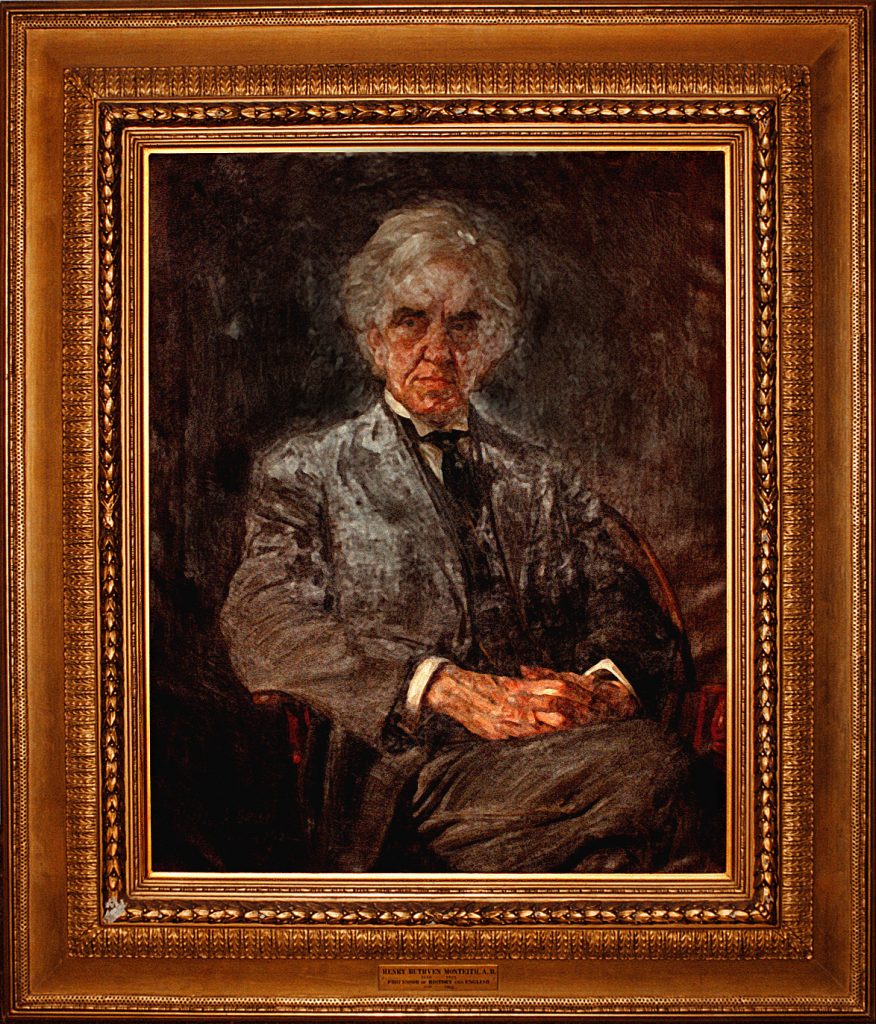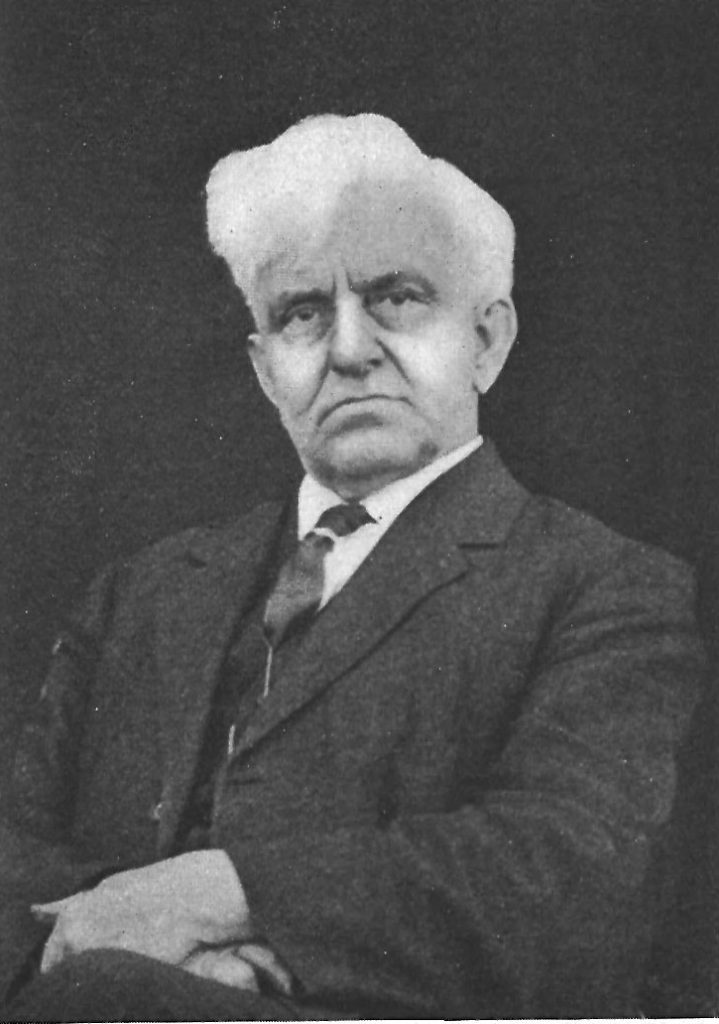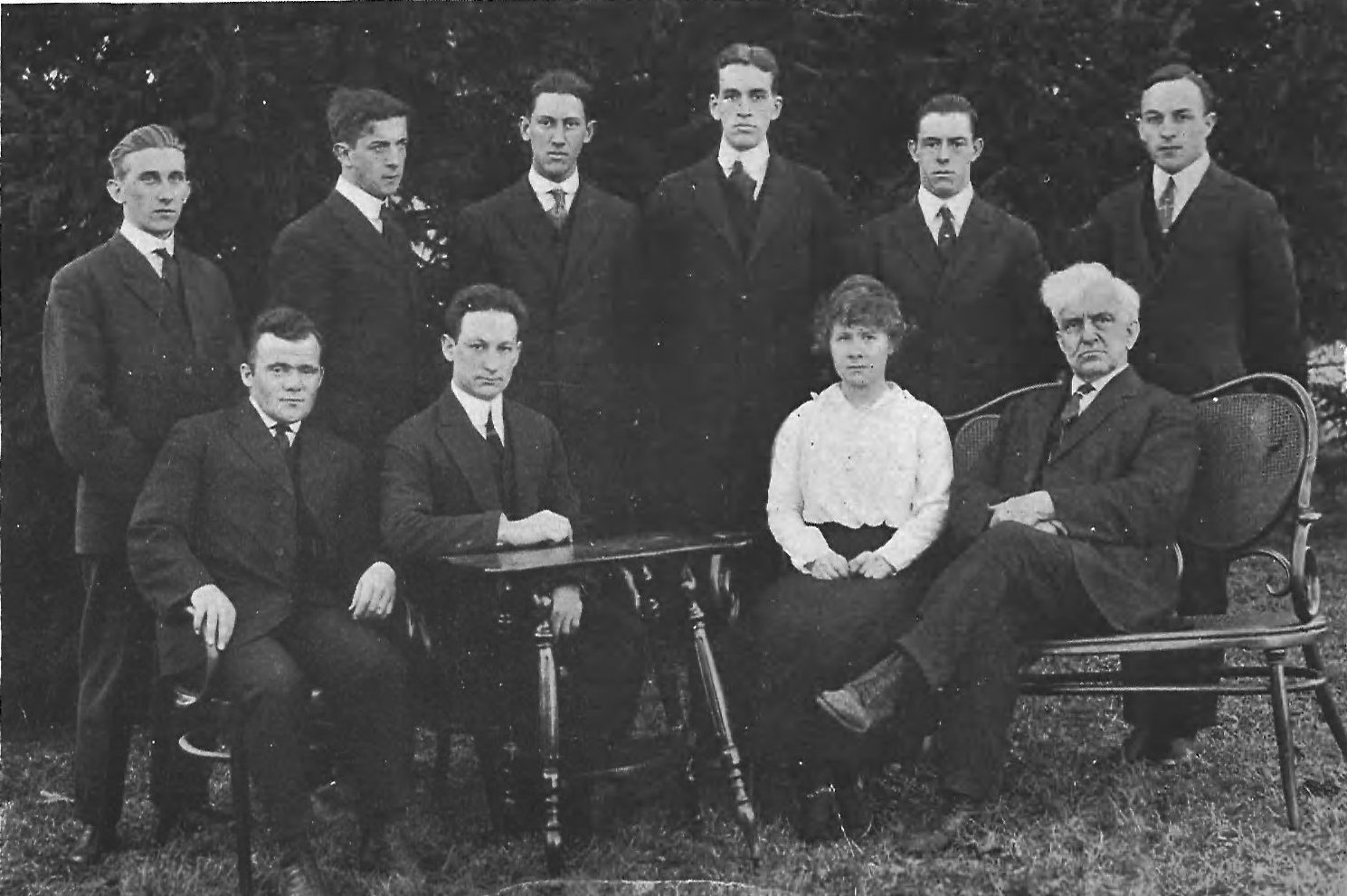Built in 1959, the Monteith Building served for many years as the home of the social sciences departments of the College of Liberal Arts and Sciences. With extensive renovations now complete, the building opens its doors this week to new occupants, the Department of Mathematics. But who was the man for whom it is named?

Henry Ruthven Monteith joined the faculty of Connecticut Agricultural College in 1900 as a professor of political economy, history, civics, and English.
He was born in Vermont in 1848, and graduated from Dartmouth with a degree in law “as one of the youngest and brightest men in his class.” He practiced law in New York City and in Vermont, before moving to Connecticut in the 1870s, where taught in the Unionville school and, from 1879 to 1899, was principal of Farmington High School.
Reflecting the evolving mission of the college in its early years, his duties changed frequently: in 1903, he is listed as a professor of history, civics, Latin, and mathematics; in 1906, Latin was dropped from the curriculum; in 1914, his title was professor of history and French; in 1916, his subjects were English and French. He retired in 1919, after nearly 20 years on the faculty, but continued to teach up until the time of his death.
Turbulent times
Monteith arrived on campus in the middle of a raging battle between the faculty and the administration, that began in 1898 when trustees replaced Benjamin Koons with George Flint as president.
The removal of President Koons, who stayed on as a professor of natural science, was unpopular with most of the faculty.
A history of the University’s first 50 years by Walter Stemmons notes that President Flint had only been in office a short time when he came into collision with certain members of the faculty.
“Opposition throughout the state began to increase as it became apparent from recurring reports from Storrs that President Flint was more interested in classical education than in agriculture,” wrote Stemmons.
There were faculty and staff resignations, and Monteith was one of the replacements hired in what became known as the “War of the Rebellion.” It ended with trustees demanding Flint’s resignation in October 1901.
In the college’s annual report for 1900, President Flint commended new faculty member Henry Monteith. “[His] experience in the class-room and his ripe scholarship are already producing the best results.” Flint knew Monteith well – they were brothers-in-law.
Stern words
For the same annual report, Monteith submitted a report for the Department of English, History, Civics, and Political Economy (not to be confused with the then-separate Department of Rhetoric, English Literature, Elocution, and Ethics).
Although he was new on the faculty, he pulled no punches:
“It is a generally recognized fact that the common schools of the State provide in English Grammar a preparation that leaves much to be desired; the deficiency in the preparation in the necessary branch is noted even in our Colleges; and in an institution like this, whose students have none of the advantages of classical study in their preliminary work, the absence of thorough training in English is of itself almost a complete bar to anything like a successful prosecution of the scientific study so generously provided here,” Monteith wrote.
He also reported that he found CAC freshmen and sophomores studying the same English lessons from the same textbook “a spectacle,” he wrote, “that it is hoped will never be repeated.”
Despite his stern words, Monteith was deeply invested in the concerns of the students.
“From the beginning of his work at Connecticut (Agricultural College), Professor Monteith manifested his deep interest in the problems and joys of the student body,” said the Connecticut Campus.
First emeritus faculty member

Monteith’s influence was felt strongly by students throughout his two decades in Storrs (he lived in Farmington, but stayed in Storrs at least three days a week). He served on many faculty committees, including the Committee on Discipline, and most notably the Committee on Student Publications. As faculty advisor, he worked closely with students on the monthly student newspaper, The Lookout, and later the weekly Connecticut Campus (forerunner to the Daily Campus). And his classes were popular:
“It had become an almost unwritten law that no Aggie man’s education was finished until he had taken a course under Professor Monteith,” said a Connecticut Campus writer.
When he retired, Monteith was named emeritus professor of history – the first faculty member of the college to receive the emeritus designation.
In 1921, work began on a portrait of the now retired professor. For months, the Connecticut Campus reported progress on the portrait, for which Monteith had begun sitting in December with Hartford artist Harold Green. The work was supervised by Robert Brandegee, one of the founders of the Connecticut Academy of Fine Arts.
Prof. Monteith, wrote a Campus reporter, will be occupied “from now until Commencement with something we hope he will like to do. We think he will be pleased and no doubt the artist will also enjoy the work, for it isn’t every day that painters are given such interesting subjects to work upon, nor, on the other hand, are professors given many opportunities to have their portraits painted.”
More than a professor
The cost of the portrait was $600, and money had to be raised to pay for it so a concert was arranged as a fundraiser by Monteith’s daughter, who taught at the Hartford Conservatory of Music, for March 23, 1922.
Three days before the concert, however, after teaching his regular 11 a.m. Senior History class, Monteith was eating lunch at the Dining Hall (now the William Benton Museum of Art) when he collapsed. Nurses from the campus infirmary were summoned, but it was too late. Monteith had died from what was determined to be a cerebral hemorrhage.
The concert was canceled, but proceeds from advance ticket sales were contributed to the portrait fund.
The 1922 Connecticut Agricultural College annual report included a memorial to the beloved professor:
“For more than 20 years he gave to the college that he learned to love so well the best efforts of a brilliant and scholarly mind. … Loved and honored by all who came within the influence of his stimulating mind and compelling personality, Prof. Monteith left behind a rich heritage.”
After a May showing at a New York City gallery, the Monteith portrait was unveiled in Storrs on June 9, 1922, the day before Commencement. The portrait was exhibited in the Dining Hall for many years, and is now in storage at the Benton Museum.
The first edition of the Nutmeg Yearbook in 1915 had been dedicated to Monteith: “His classes are all proud of the ‘Grand Old Man’ of Connecticut, and honor and revere him as the highest type of that which we all aspire to be – ‘a gentleman and a scholar’.” He was also named ‘Favorite Prof’ that same year.
The 1922 Nutmeg carried a similar dedication, not to the man but to his memory. But a glimpse of his persona and his influence comes from a short piece about the forthcoming portrait that ran in the Dec. 22, 1921 Connecticut Campus.
The piece includes an imaginary dialogue taking place in some future time in front of the completed painting, in “a magnificent library and auditorium at Connecticut. In the center hall will hang the portrait of a fine old man.” The writer eavesdrops, as a visitor views the painting.
Henry Ruthven Monteith – he must have been quite a man.
A great man, sir!
Ah, you knew him, then? He was brilliant?
He was a great scholar, and very wise.
A professor wasn’t he?
A professor? Yes, certainly, sir. A professor. But he was more than a professor, he was ‘Monty.’
Adapted from an article in the UConn Advance newspaper dated Nov. 30, 1998.
Sources: The Connecticut Campus, various issues, Vol. VII and Vol. IX, 1922-1923; Connecticut Agricultural College: A History, Walter Stemmons, 1931. These and other materials on UConn’s history are in the University Archives.



